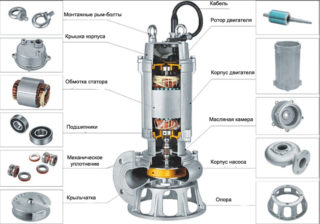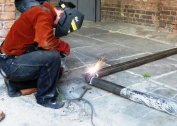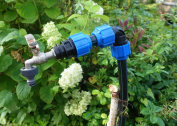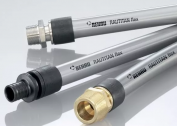Any pressure equipment that is used for domestic and industrial wastewater systems, no matter how reliable, may suddenly fail. For this reason, it is better to have spare parts at hand, thanks to which you can quickly bring the plant into operation.
Types of drainage pumps
Units of this type are submersible and surface. A feature of the former is that during the process it is completely immersed in the pumped liquid. Contaminated water is drawn in through the drain hole located at the bottom of the casing. A special strainer serves to protect the impeller from large solids and dirt.
Most often, a submersible drainage machine is used when pumping water from basements and basement floors.
The installation of powerful ground-based devices is carried out on the surface at the edge of the reservoir or drain pit. The drain hose that draws in water drops inward. The advantages of such a device are mobility. Also, commissioning is not required. Cons - in the great price and weight of the installation. In addition, surface pumping equipment is leaking, so water is not allowed on it.
Drainage pump
It is better to find out what is inside the unit immediately after the acquisition in order to have an idea of possible breakdowns and potential clogging places. For this purpose, you do not need to open the case or disassemble the pump - just look at the diagram in the connection and maintenance manual for the installation.
Pumps for private use in cottages, as a rule, are not very powerful and with a simple internal device. Unlike heavy industrial plants, they are small, relatively light - up to 7 kg. Parts are made of steel or plastic, although cast iron is still used to produce some models.
The main components of a standard drainage pump:
- A water pump and an electric motor that rotates the impeller shaft. The motor for the drainage pump is located in a durable case made of stainless steel or reinforced polypropylene polymer, and is made like a thermos. Between the external and internal walls, fluid constantly moves, preventing the device from overheating.
- The impeller for the drainage pump is a screw device that delivers water inside the housing. It is mounted on an axial shaft. When the device is started, the blades come into motion, they take the liquid from the outside and push it along the walls to the outlet. The first portion is replaced by the second - and so on until the pump is turned off.
- Float. It serves to adjust the frequency of work and monitors the water level in the tank or natural reservoir. With a sharp decrease, it automatically turns off the device.
- Check or non-return valve. This element protects the device from leakage of the pumped-over liquid.
Modern models are equipped with thermal protection, which works when the device is overloaded. This function is performed by a thermal relay, which blocks the start of an overheated engine or stops the supply of electricity in a timely manner.
Damage to pressure equipment requiring replacement of spare parts
From failure both the new device and the pressure apparatus, which has worked for several years, are not immune.A newly purchased unit may break as a result of a defect that was admitted during production: a defective piston or an incorrectly connected non-return valve.
Often the cause of failure becomes an inept installation:
- the device is lowered to insufficient depth;
- air has entered the water intake compartment;
- the suction port is located above the water mirror and is not covered by water.
Such defects are quickly corrected by a regular check, but it is better to ensure that they do not occur.
In most cases, problems appear when the equipment is in operation. The manufacturer has set control parameters that allow the device to work in optimal mode. They are indicated in the product data sheet. If the device was used incorrectly or for other purposes, it simply breaks from overload.
Most often you have to replace:
- impeller;
- float;
- check valve.
If the motor fails, it is likely that the bearings that need to be replaced are worn out. Also, the starting capacitor may burn out or the hose may wear out.
Fittings and couplings often break. For example, plastic adapters - straight and angled - for connecting hoses to a drainage pump. Sometimes it is necessary to replace metal connecting elements - fittings.
Spare parts for fecal pumps are similar, but this device is equipped with a grinder that helps break up soft, but large formations. At the same time, drainage machines can pass solid particles, but not larger than 12 mm.
Criterias of choice
When selecting the impeller, the design of the device and the material of the product itself are taken into account. In its manufacture can be used technopolymer - wear-resistant, durable, not afraid of corrosion. Produce parts and stainless steel. The latter material is stronger, but models with its use are more expensive.
The new float must be exactly the same size as the failed part. Thus, the owner of the unit will avoid difficulties when replacing.
When choosing a new hose, it is worth considering the following parameters:
- Rigidity. The hose should not collapse, contract, become soft with a sudden drop in pressure. Corrugated pipes with compacted walls and products with reinforcing inserts retain their shape better.
- Immunity to cold. It is important for year-round use of pumping equipment.
- Wear resistance of the material.
- Diameter and length of the product.
When purchasing a check valve, you need to choose the part that will fit the pumping equipment in size. Choosing straight and angular adapters, fittings, it is necessary to consider the method of connection with the main parts and the cross-section of the fittings.
Measures to reduce the cost of spare parts
In order for the device to last longer and not have to spend money on spare parts, it is necessary to follow the manufacturer's recommendations.
Additional engineering solutions to increase the operational life of the device:
- Connecting the unit through differential automatic protection allows you to prevent its breakdown during ripple, power surges and short circuit.
- With increasing distance between the casing and the impeller, the pressure of the liquid decreases and the load on the electric motor increases.
- If the housing is positioned such that the intake device is a certain distance from the base of the tank, it will not pick up coarse-grained debris.
Do not confuse drainage equipment with fecal - the first is not equipped with a special grinder and can not cope with the movement of large inclusions.
The electric wire and internal parts require a functional check at least once a year. To do this, disassemble the housing and perform preventive cleaning, which increases the service life of parts by several times.





